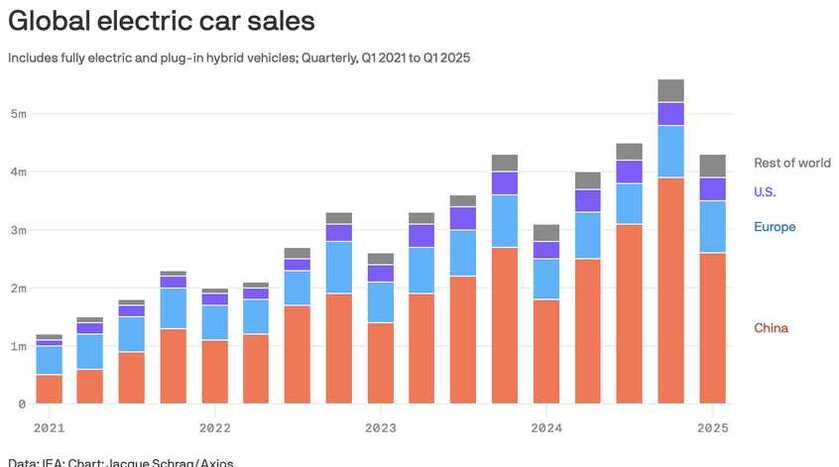
The EV industry is growing faster than ever
Electric vehicles have officially gone mainstream. EVs (including plug-in hybrids) are now on pace to make up one-fourth of all global car sales this year, according to new data from the International Energy Agency. That’s a sharp rise from just 4% in 2020. Nearly 6 million EVs were sold worldwide in Q3 of last year, with China leading the charge, followed by Europe and the United States.
Battery electric vehicles (BEVs) in particular have made rapid gains, climbing from less than 2% of global new car registrations in 2019 to over 14% by early 2025. (Over that same period, combustion engine car sales fell from 91% of new sales to 57%.) BEVs are now the second most popular transmission system globally, behind only traditional gas-powered engines.
The momentum is both policy-driven and consumer-driven. The EPA recently finalized rules that will require automakers to cut emissions from new vehicles by 50% between model years 2026 and 2032. To meet those targets, EVs will need to make up 35% to 56% of new car sales, with plug-in hybrids accounting for another 13% to 36%. And roughly a dozen states still plan to ban gas-powered vehicle sales by 2035.
Prices have also improved. The average EV now costs around $57,000, down from nearly $67,000 in mid-2022. Used EVs are down even more. More model variety and growing inventory have helped narrow the affordability gap — and as production scales, prices may fall further.
So far, EV adoption also reflects a clear generational divide. According to Statista, 22% of U.S. millennials now have a plug-in or fully electric vehicle in their household. Gen Z (not all of whom are adults yet) isn’t far behind at 14%. And just 4% of Baby Boomers report owning an EV. As younger buyers gain market share, EV adoption will likely accelerate even without government incentives.
And behind the scenes, the global EV production map is reconfiguring itself. Tesla and Ford ramped up EU-based manufacturing in 2024, though some European automakers have seen output stagnate. U.S. EV production actually fell 7% last year, but output in Mexico — led by U.S. brands — continued to grow. In Europe, Chinese companies are now building EVs locally as they expand their footprint.
In the United States, all of this progress is happening despite a major policy reversal. The recently passed “Big Beautiful Bill” officially ends the $7,500 federal tax credit for new EVs and the $4,000 credit for used ones. Buyers have until September 30 to qualify before those incentives disappear, a move that could make EVs less accessible for many lower- and middle-income drivers. Still, analysts say the EV math continues to work out in the long run: They tend to cost less to operate, require less maintenance, and deliver fuel savings that can offset their higher upfront cost within a few years, depending on how often you drive and where you live.

The 2025 Canadian Politician of the Year
and a review of the year’s top dozen political news columns
https://bygeorgejournal.substack.com/p/the-2025-canadian-politician-of-the















